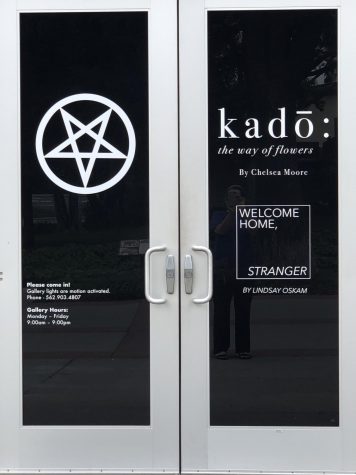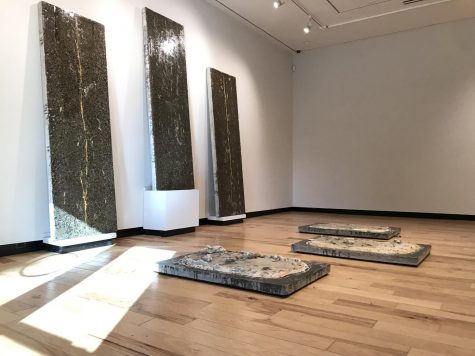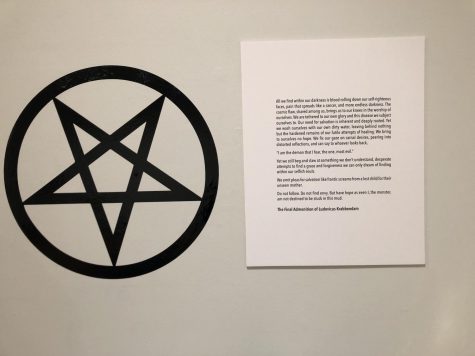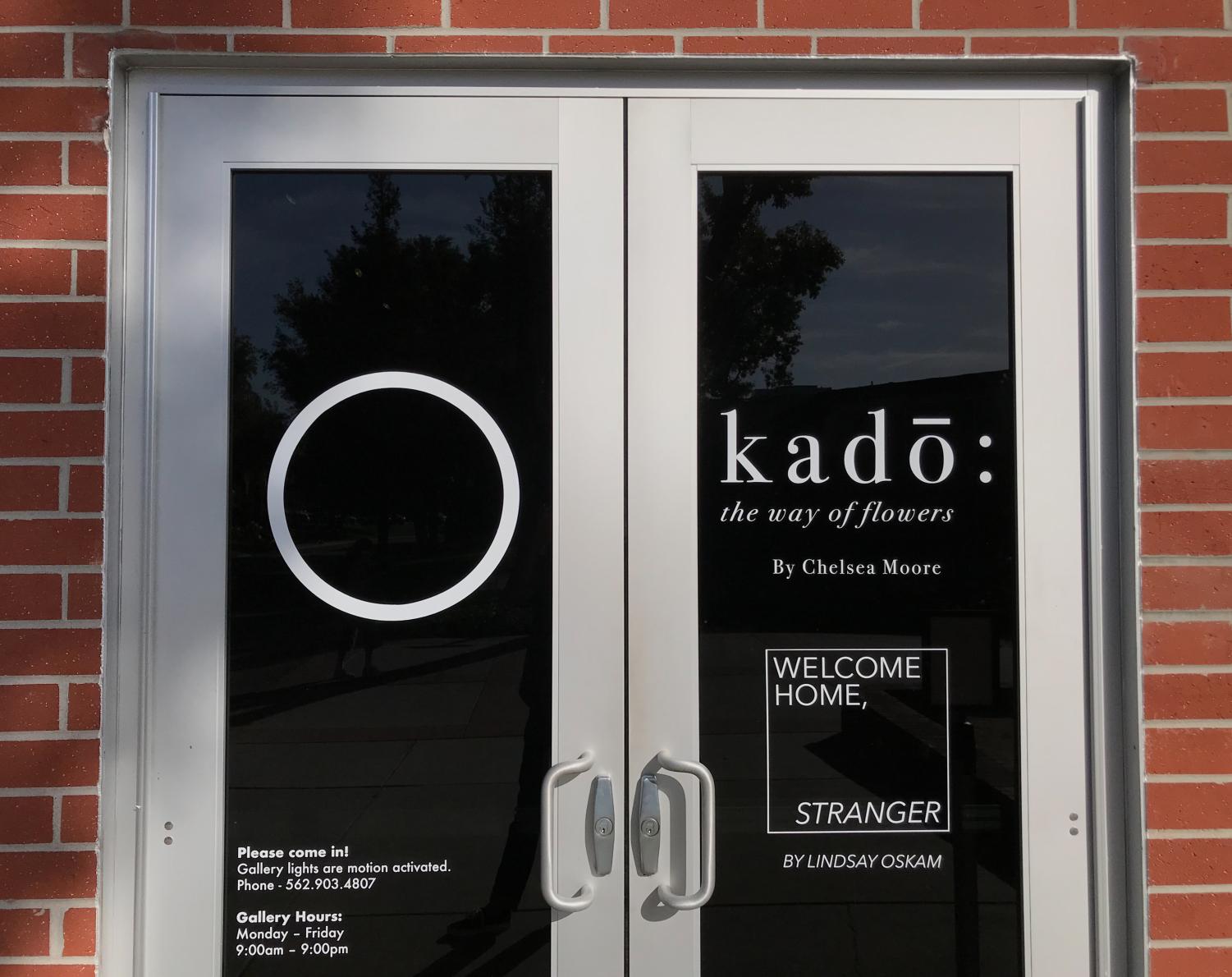
On April 27, a pentagram—the symbol often associated with satanic or occult imagery—appeared on the door of the Earl & Virginia Art Gallery. The image, which senior studio art major Ludo Krabbendam used as the show title for his senior showcase exhibit, was promptly removed by the art department due to miscommunication. Both the image and its removal have caused controversy among the student body, as some believe it should never have been displayed, while others think Krabbendam’s voice has been censored.
Some students expressed discomfort over social media, arguing the situation was made worse since it was displayed so publicly.
BEHIND THE PENTAGRAM
Krabbendam says his exhibit is not a satanic ritual. The four-piece exhibit asks Christians to think about where they are relying on themselves instead of God. In its entirety, his exhibit consists of Krabbendam’s show title—the pentagram—along with sculptures, a statement from the artist and a live performance that took place Monday night. Inside the gallery are three massive concrete slabs with a glossy resin over the surfaces. Gold leafs and cracks have been chiseled throughout the slabs. Krabbendam says he wanted to challenge his viewers to think about the idols that stand in place of God in their lives.
“My whole show is about the dangers of the pursuit of your carnal desires,” Krabbendam said. “[It’s about] everyone’s inherent need for salvation and the things we substitute God for in our lives and all the things we do on a daily basis—whether we admit it or recognize it or not—in an attempt to find salvation. To find some sort of spiritual cleansing for ourselves instead of looking to God for that salvation that we all intrinsically need and understand that we need.”
According to Krabbendam, his use of the pentagram was supposed to represent satanism, which he says is a religion not about worshipping Satan, but that worships one’s self. While there are theistic strands of satanism that do worship the devil, there are also atheistic strands that focus on human tendencies.
“It was an intentional decision, not something I did to just poke the bear,” Krabbendam said. “It was a very specific choice that speaks into the rest of my work and helps to understand the exhibition as a whole… I feel like it’s something that’s so visually jarring and causes people to recoil. When you’re confronted with it and you confront yourself with it, you can see perhaps this isn’t far off of things that I do [as a Christian] everyday.”

MISCOMMUNICATION LED TO REMOVAL
He understood the image would probably be viewed out of context and would be controversial, so he emailed the art department the day before his exhibit was displayed in the gallery. He said his email gave the department a notice that he would use symbols that may be offensive or uncomfortable to some people.
However, he was too late. While the art department says they promote artistic expression and exploration, it also maintains Krabbendam should have discussed his concepts and use of show title with the department much earlier. In an internal email to the art department forwarded to the Chimes, associate professor of art and chair of the art department Zehavi Husser wrote, “In the case of the objects/imagery that were removed: the student did not conceptually collaborate with any of the professors of the Art Department in the use of certain imagery in the senior show exhibition.”
Because the show title is displayed in public, associate professor of art history and painting and associate dean of the School of Fine Arts and Communications Jonathan Puls says they have to vet everything on the outside of the gallery with very specific criteria, especially since the image could be taken out of context. He ultimately appreciates Krabbendam’s usage of difficult and controversial imagery, but wishes there was a better way to navigate the entire situation. He does not believe Krabbendam was censored, but says the art department took the necessary reactionary steps for the controversy surrounding the image.
“Trying to deeply understand how imagery functions and speaks and how it’s contextualized is what an art degree is all about,” Puls said. “In this case, things went sideways because there wasn’t communication about that ahead of time.”
UNDERSTANDING THE CONTEXT
However, some students still believe Krabbendam should have been able to express himself regardless of imagery chosen. They point out that those confused by the five-pointed star could have easily walked inside of the gallery to find the full context.

“I think the point of art is to catch your attention and to tell something to you,” said senior psychology major Tori Pflanzer. “If people would have walked in and read the plaque on the wall, they would have immediately understood why he chose the symbol he did.”
Regardless of the intended context, some students believe it is simply wrong to publicly display images associated with demonic symbolism. Freshman history major Evan Lockett believes there could have been a better way for Krabbendam to get his point across, just as he believes Christians should not go out of their way to understand heresies because he believes power arises from attention.
“I think that it is wrong to publicly display demonic imagery because I believe it gives the enemy power by giving him an avenue into people’s lives…” Lockett said in an email. “I think that publicly displaying a pentagram further propagates demonic influence.”
Krabbendam believes the removal of the pentagram took away part of the message he was trying to tell. He hoped his art could prompt Christians to look deeply into the places where they replace God. From the pentagram to his artist statement to the sculptures, he says he intended his story and message to be seen through an image that represents worship of self.
“Let’s dive in there and confront our own selves, the darkest, darkest places within us in an attempt to get closer to God, to see where those parts in our lives where we need more God, even the things we don’t admit to ourselves,” Krabbendam said. “I believe there is a lot that people can hide from even their own understanding about themselves. Running and hiding from anything is not a way to begin growth.”












